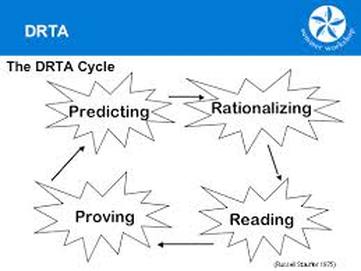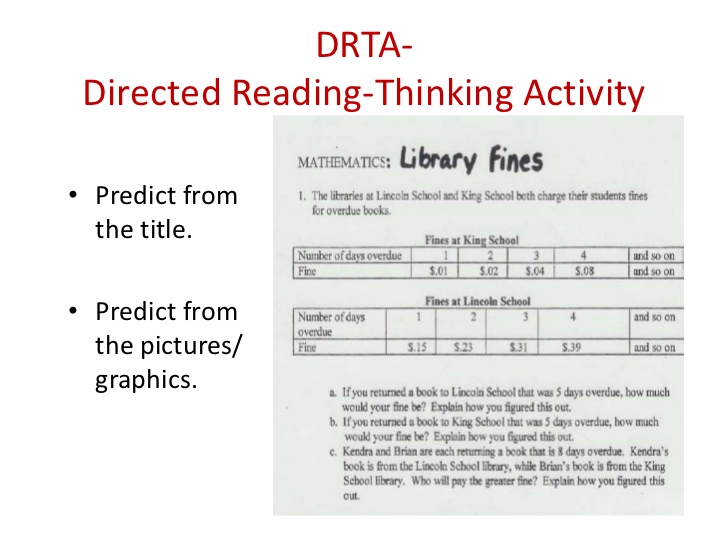Directed Reading Thinking Activity (DRTA)
Definition/Description: The Directed Reading Thinking Activity (DRTA) is a comprehension strategy that is used during reading to guide students in asking questions about a text and making predictions. They then keep reading to figure out if their prediction was correct or not. This can be done individually, in a small group, or as a whole class. "The DRTA process encourages students to be active and thoughtful readers, enhancing their comprehension" (Reading Rockets, 2015). Typically the teacher will read students the passage and have them do the thinking and predicting part. "These predictions, and confirmations (or revisions) guide she students' understanding of the story (Jennings, Caldwell, andLerner, 2014).
|
This video is VERY informative on what Directed Reading Thinking Activity (DRTA) is and how to implement the strategy in a classroom setting
|
Justification:
This strategy is good for all students, especially those with learning disabilities and struggling readings, mainly due to the repetition within the strategy. Also this strategy gives students time for thinking, they are constantly predicting what will happen, justifying and explaining, and going back to see if the prediction was correct or not and fixing it if not (Jennings, Caldwell, and Lerner, 2014). There was a study done by Schorzman and Cheek on the effects of the DR-TA along with a pre-reading plan and graphic organizers. It was done among three middle school classes and compared to a control group of three other teachers at a different middle school. The results indicated that these strategies used together resulted in significant pre-post student gains on a cloze test (Schorzman, E. & Cheek, E. (2004). If teachers use graphic organizers as an after activity this will help with the visual representation of students. "Research findings indicate that graphic organizers can be effective tools to support comprehension for all students, including those at risk for academic failure" (Miller, and Veatch, 2011). DR-TA allows students to higher-order thought processing and provides teachers with a significant amount of information about each student's ideas, thought processes, prior knowledge and thinking skills.(Tankersley, 2005). |
|
Steps:
Differentiation for Struggling readers:
|
Purpose:
The purpose is to help encourage student to be active and thoughtful reader and to activate prior knowledge and background knowledge to gain a better understanding of reading and the material. Also it helps student develop monitoring while reading, because they are always checking to make sure their prediction are right and they are understanding. Lastly, it uses critical thinking skills, which is necessary in the 21st century This video starts with the definition of Directed Reading Thinking Activity and some points that teacher might find useful. Then it goes into an example of teaching special education students using this strategy!
|
|
Content Area Examples:
This strategy can be used in any subject not just reading. It can be used in math, science, and social studies as well. The picture to the left demonstrates an example of how DRTA can be used in math. In this example students make a prediction based on the title, picture clues, and graphics, they read the material, such as a short story about the topic or questions. Students then assess their predictions and adjust them and the answers if need. Students can read a book about a science topic or social studies topic and go through the steps. For example student read a book about the life cycle and go through predictions and the process. Or it could be something similar to the math example to the left! |
References:
Directed Reading Thinking Activity (DRTA) (2015). Reading Rockets. Retrieved from http://www.readingrockets.org/strategies/shared_reading
DRTA Math Example (n.d). [Image] Retrieved form http://www.slideshare.net/pondskater/pre-reading-strategies
Jennings, J., Caldwell, J., & Lerner, J. (2014). Reading problems assessment and teaching strategies. Boston, MA: Pearson Education, Inc.
Miller, M., & Veatch, N. (2011). Literacy in Context (LinC): Choosing Instructional Strategies to Teach Reading in Content Areas for Students Grades 5-12. Pearson.
Schorzman, E. & Cheek, E. (2004). Structured strategy instruction: Investigating an intervention for improving sixth-graders’ reading comprehension. Reading Psychology, 25(1), 37-60.
Stauffer, R., (1975). DRTA cycle. [Image]. Retrieved form http://drta.wikispaces.com/Strategy+Description?responseToken=0ed8d3cb27a27359f2dcdb046dee428a1
Tankersley, K. (2005). Literacy Strategies for Grades 4-12: Reinforcing the Threads of Reading. Alexandria, VA: Association for Supervision and Curriculum Development.
Directed Reading Thinking Activity (DRTA) (2015). Reading Rockets. Retrieved from http://www.readingrockets.org/strategies/shared_reading
DRTA Math Example (n.d). [Image] Retrieved form http://www.slideshare.net/pondskater/pre-reading-strategies
Jennings, J., Caldwell, J., & Lerner, J. (2014). Reading problems assessment and teaching strategies. Boston, MA: Pearson Education, Inc.
Miller, M., & Veatch, N. (2011). Literacy in Context (LinC): Choosing Instructional Strategies to Teach Reading in Content Areas for Students Grades 5-12. Pearson.
Schorzman, E. & Cheek, E. (2004). Structured strategy instruction: Investigating an intervention for improving sixth-graders’ reading comprehension. Reading Psychology, 25(1), 37-60.
Stauffer, R., (1975). DRTA cycle. [Image]. Retrieved form http://drta.wikispaces.com/Strategy+Description?responseToken=0ed8d3cb27a27359f2dcdb046dee428a1
Tankersley, K. (2005). Literacy Strategies for Grades 4-12: Reinforcing the Threads of Reading. Alexandria, VA: Association for Supervision and Curriculum Development.


